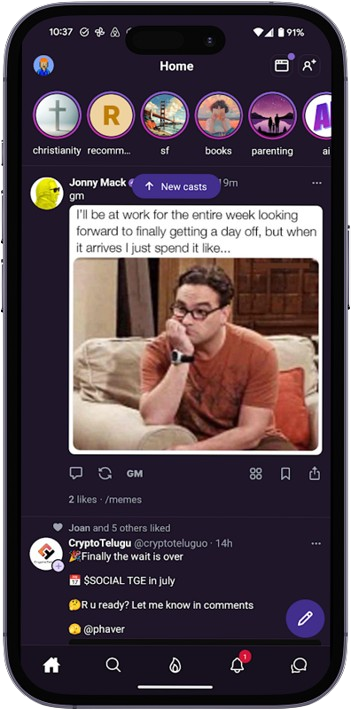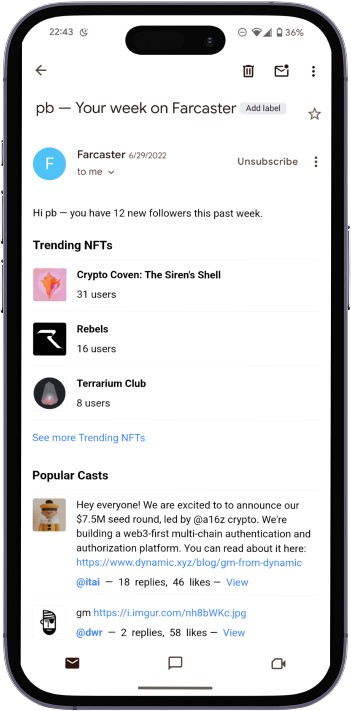 Farcaster UI circa June 2024.
Farcaster UI circa June 2024. Farcaster UI circa June 2024.
Farcaster UI circa June 2024.
I originally stumbled upon Dan Romero on Twitter (I think), which then led me to his blog, which I found nice and simple and subsequently forked and adapted as you can probably tell. He was at Coinbase at the time, but I took notice when he revealed that he was building a new social network on crypto rails called Farcaster.
As far as blockchain went I had dabbled in the casino side (h/t to bro-in-law Frank-형), but was inexperienced with the computer side, and yet I was curious to learn about it—NFTs and so forth—and so I DM’d Dan 2022-06-21 to jump on Farcaster and joined the Android Alpha the very same day.
It was funny to be joining a new social network because I had deep-sixed my Facebook and Instagram accounts nine months earlier for all the typical reasons.
So it does beg the question…

On that last point, this was something people frequently mentioned and agreed, typified by this “cast”:
I’ve been exploring FC for several months. I basically follow and engage with FC builders and Purple people and those that are drawn to that culture. I realized something today. I haven’t come across one thread of animosity or contention. It’s builders encouraging and helping one another. That’s appealing.
And others, e.g., @winnie, wondered aloud how to preserve said vibes:
love Farcaster, but one question I have is how to scale such a high-signal, strong community without losing some of the magic we have today on this app? conversations here are very reminiscent of early-days clubhouse, but how do we maintain this as it exits beta / becomes open?
This is a hard balance to strike. The Twitter clone “Pebble” (f.k.a. T2), which launched in November 2022 and met its death the following November, was attempting to be a “nice Twitter” and ultimately people passed on nice in favor of intriguing—I secretly wonder if Threads will see the same fate. And so while civility is lovely, you still need a contingency that will stir the pot and be a little provocative lest people find themselves terribly bored.
I admit I was a little skeptical about the long-term prospects of a social network starting up in 2021 overcoming the “cold start problem,” but the crypto community is vibrant, smart, competitive. I also now subscribe to Kevin Kelly “1000 true fans” concept2. Case in point: Farcaster was certainly a Twitter clone out the gate as far as UX/UI, but then “Channels” were introduced, which allowed for niche communities à la Reddit. Channels gained transaction almost immediately with some 30% of casts going through them within the first month. The Farcaster founders (Merkle Manufactory) think of this as allowing communities to be created and nurtured with some portion of them having the chance at lasting, long-term value.
I can’t remember if Dan came up with this or it was someone else, but in some ways scaling web3 needs to follow the mullet paradigm: business in the front; party in the back…but in this case web2 (ease of use) in the front; web3 (sundry benefits of decentralization) in the back (or, shall we say, underneath?). I.e., once web3 social crosses the chasm into the mainstream, many people won’t care about blockchain or Ethereum or L1 or L2 networks per se, but only the benefits afforded them…and, in fact, they won’t tolerate the current clunky UX with wallet signatures as a trade-off—I’m sorry: I realize this has been stated tens of thousands of times.
Users want whatever’s differentiated about this new-fangled network, which in the short-term, as we said, is an inspirational collection of delectable humans; but in the long-run is theoretically what is intrinsically valuable about blockchain.
…but here are a few early ones that bubbled up that got my attention:
Of course this is just the beginning, but that’s a bit of my experience to date. I may be a fringe user, but it’s been fun to participate in this community of interesting people and observe the evolution of the platform.
Excelsior,
— ᴘ. ᴍ. ʙ.
Merkle Manufactory, the company behind Farcaster and Warpcast, is a pacesetter in this respect for the entire community, shipping pretty major stuff almost weekly at one point. ↩
Kevin Kelly’s 2008 blogpost and concept that you don’t need to convert the total available market to your product; rather you need a narrow segment that will stick with you through thick and thin, buy everything you drop on the market, and evangelize your product to their friends. ↩